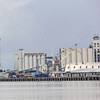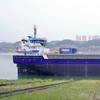In preparation for an historic
first shipboard landing by the U.S. Navy's RQ-8A Fire Scout vertical
takeoff and landing tactical unmanned air vehicle, Northrop Grumman
Corporation conducted two successful test flights of the
UAV in late August.
The flights were made between Pt. Mugu Naval Air Station,
Calif., and the USS Denver underway at sea. During both flights, air
vehicle and mission payload operators aboard the Denver used the
Raytheon-developed Tactical Control System (TCS) software and the
Navy's S-280 ground control station to control the Fire Scout and its
payload from launch to recovery. Fire Scout is the first UAV system to
be fully TCS compliant.
"The recent test flights helped us ensure that every aspect of
the Fire Scout operation is consistent with the requirements of the
shipboard environment," said Tom Soard, Northrop Grumman's Fire Scout
program manager. "It's part of our commitment to demonstrate the vital
surveillance and reconnaissance role that unmanned air vehicles can
play in the Navy's future littoral force structure."
Northrop Grumman's Integrated Systems sector leads the Fire
Scout test team. The team also includes the crew of the Denver; as
well as representatives from the Naval Air Systems Command and PMA-263
(the U.S. Navy's UAV program office), and the Raytheon Company.
Northrop Grumman's Electronic Systems sector, headquartered in
Baltimore, provides the Fire Scout's payload, which consists of
electro-optical and infrared sensors and a laser designator/range
finder. The team plans to conduct precision approaches to the Denver
and the first shipboard landings later this fall.
The first Fire Scout test flight, conducted Aug. 21, served as
a functional check flight. It occurred near the Denver and lasted
approximately 20 minutes. During a 1-1/2 hour second flight conducted
Aug. 23, the UAV made several approaches to the Denver and responded
successfully to several intentional, operator-directed wave-offs. The
second flight also demonstrated Fire Scout's ability to fly navigation
and approach routes relative to a moving platform.
The Fire Scout system is in development and low-rate initial
production by Northrop Grumman for Naval Air Systems Command, Patuxent
River, Md. It can serve as a force multiplier for Navy forces at sea
and U.S. Marine Corps forces ashore. The air vehicle, which can
operate at altitudes up to 20,000 feet, watches for threats within 150
nautical miles of its ground control station. The system also can
direct Navy and Marine weapons accurately to a target either by using
its laser designator or by providing precise target location
coordinates.
Featured videos

Tracking Foreign Vessels Working in the U.S. Jones Act Market

Inside the Electrified Truckable Tug

Inmarsat Enhances Service to Drive Digitalization
Subscribe for
Maritime Reporter E-News
Maritime Reporter E-News is the maritime industry's largest circulation and most authoritative ENews Service, delivered to your Email five times per week









